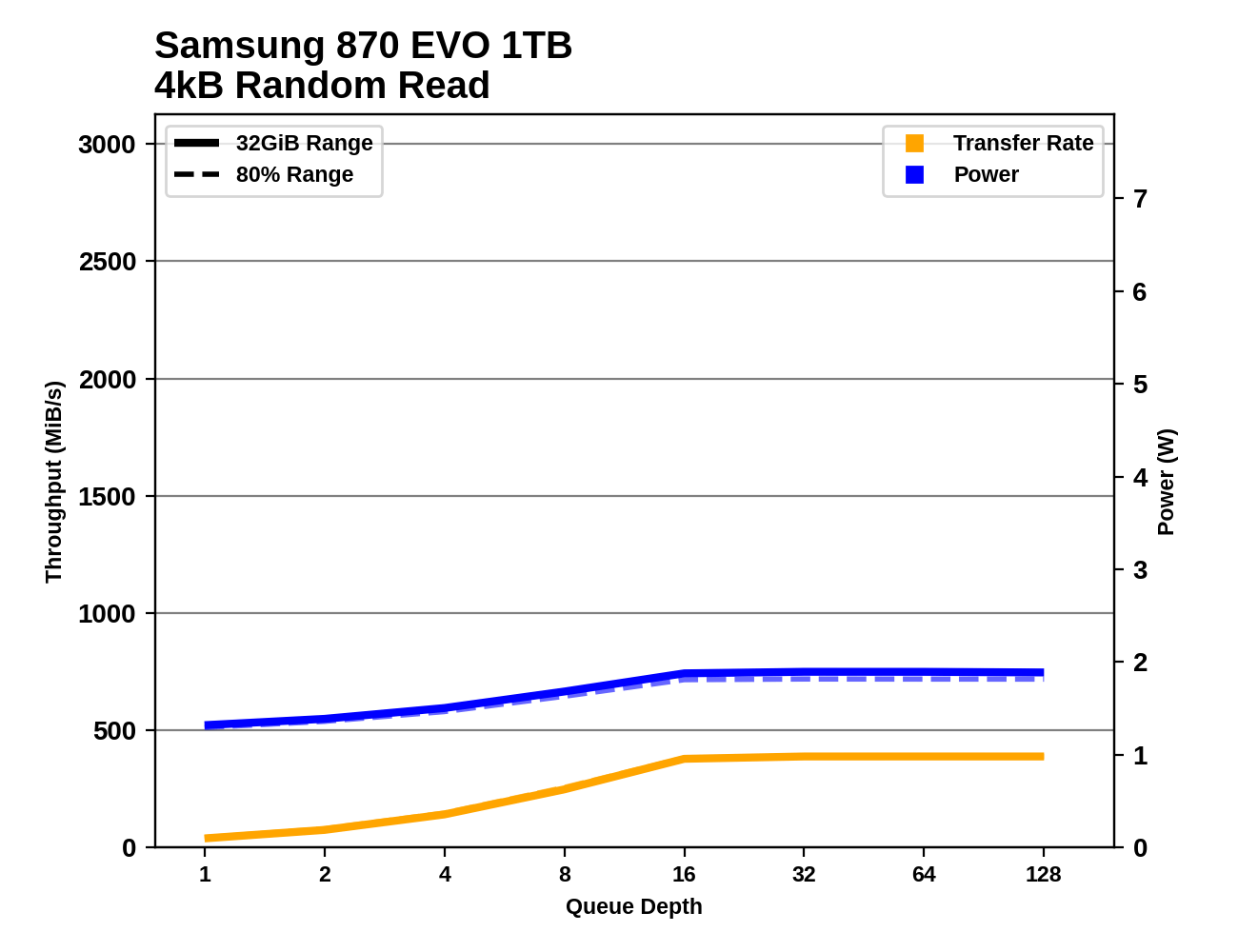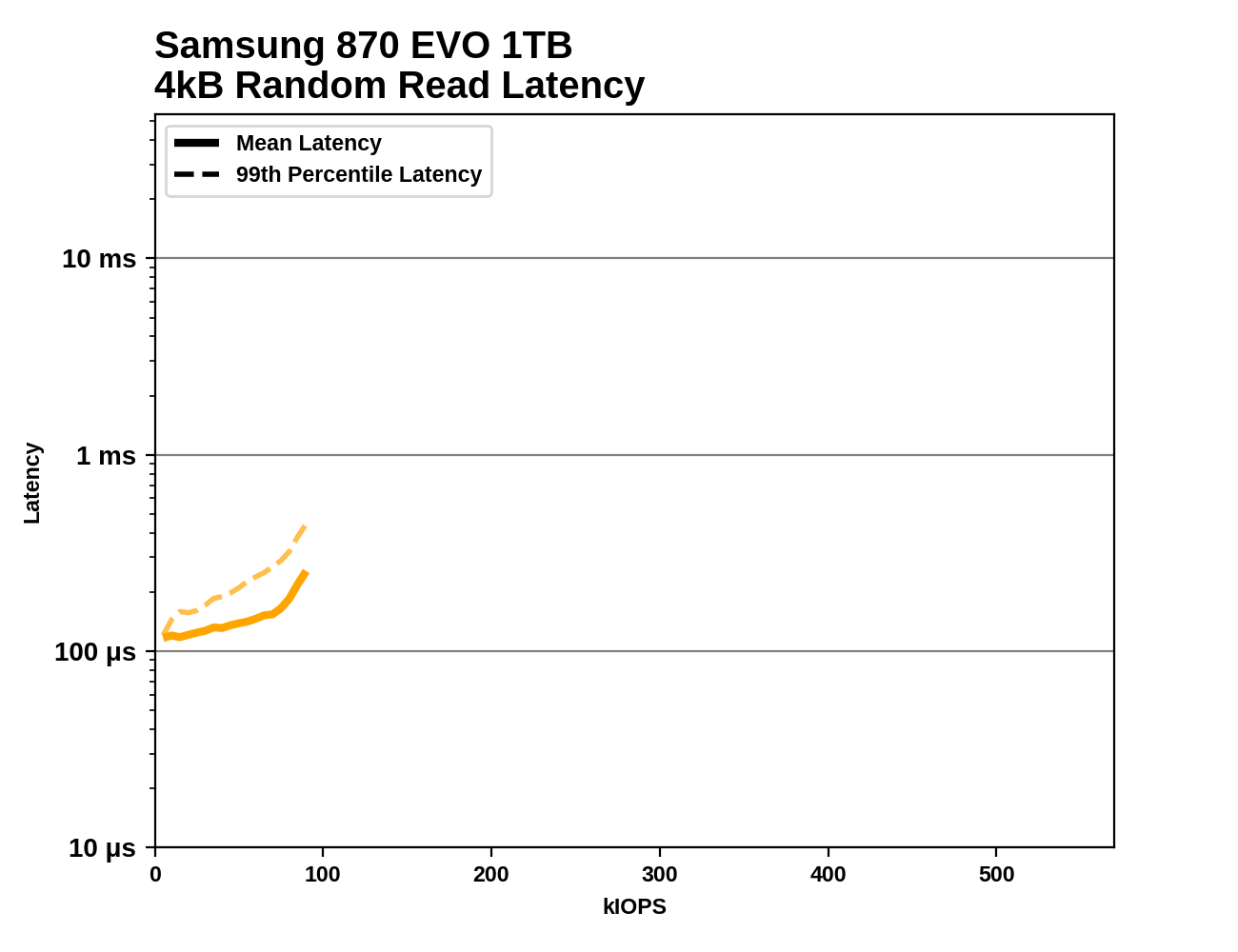The Samsung 870 EVO (1TB & 4TB) Review: Does the World Need Premium SATA SSDs?
by Billy Tallis on February 17, 2021 8:00 AM ESTBurst IO Performance
Our burst IO tests operate at queue depth 1 and perform several short data transfers interspersed with idle time. The random read and write tests consist of 32 bursts of up to 64MB each. The sequential read and write tests use eight bursts of up to 128MB each. For more details, please see the overview of our 2021 Consumer SSD Benchmark Suite.
 |
|||||||||
| Random Read | Random Write | ||||||||
| Sequential Read | Sequential Write | ||||||||
Our burst IO tests show little to no performance differences between the Samsung 870 EVO and other top SATA SSDs. The 1MB sequential transfers are already hitting the SATA throughput limits even at QD1, and the 4kB random IOs are at best marginally improved over Samsung's previous generation. Samsung's slight improvement to random read latency is enough to catch up to Micron's as shown by the Crucial MX500, but a 10% gain hardly matters when NVMe drives can double this performance.
Sustained IO Performance
Our sustained IO tests exercise a range of queue depths and transfer more data than the burst IO tests, but still have limits to keep the duration somewhat realistic. The primary scores we report are focused on the low queue depths that make up the bulk of consumer storage workloads. For more details, please see the overview of our 2021 Consumer SSD Benchmark Suite.
 |
|||||||||
| Random Read | Random Write | ||||||||
| Sequential Read | Sequential Write | ||||||||
On the longer synthetic tests that bring in some slightly higher queue depths, the improved random read performance of the 870 EVO is a bit more clear. In one sense it is impressive to see Samsung squeeze a bit more performance out of the same SATA bottleneck, but we're still talking about small incremental refinements where NVMe enables drastic improvements. Aside from random reads, the 870 EVO's performance improvements are exceedingly minute and it should be considered essentially tied with most other recent mainstream TLC SATA drives.
 |
|||||||||
| Random Read | Random Write | ||||||||
| Sequential Read | Sequential Write | ||||||||
Power consumption is one area where Samsung could theoretically offer more significant improvements despite still being constrained by the same SATA interface, but the 870 EVO doesn't really deliver any meaningful improvements there. The 4TB model is consistently a bit less efficient than the 1TB model on account of having more memory to keep powered up, but when comparing the 1TB model against its predecessor and competing drives there's nothing particularly noteworthy about the 870 EVO. SK hynix's Gold S31 has a modest efficiency advantage for random IO while Samsung is technically the most efficient of these SATA drives for sequential IO.
 |
|||||||||
| Random Read | |||||||||
| Random Write | |||||||||
| Sequential Read | |||||||||
| Sequential Write | |||||||||
The queue depth scaling behavior of the 870 EVOs is almost identical to the 860 EVOs and still quite typical for mainstream SATA drives. For random reads the 870 EVOs saturate around QD16, while for random writes QD4 suffices. On the sequential IO tests there's only a small performance gain from QD1 to QD16, and the more interesting question is how stable performance is through the rest of the sequential tests. The 1TB 870 EVO seems to run out of SLC cache a bit earlier than the 860 EVO when the sequential write test is running on an 80% full drive, but the 4TB model has plenty of cache to finish out that test at full speed.
Random Read Performance Consistency
This test illustrates how drives with higher throughput don't always offer better IO latency and Quality of Service (QoS), and that latency often gets much worse when a drive is pushed to its limits. This test is more intense than real-world consumer workloads and the results can be a bit noisy, but large differences that show up clearly on a log scale plot are meaningful. For more details, please see the overview of our 2021 Consumer SSD Benchmark Suite.
 |
|||||||||
Consistent with most of our other read performance tests, the Samsung 870 EVO shows slightly better average and 99th percentile random read latencies than most of its SATA competition. Even some of the entry-level NVMe drives that can deliver higher random read throughput than is possible for the 870 EVO still have clearly higher latency across most or all of the throughput range that the 870 EVO can cover. A QLC-based or DRAMless TLC NVMe SSD can potentially offer far higher throughput than any SATA SSD, but clearly beating the 870 EVO on both throughput and latency requires stepping up to a more mainstream NVMe design with DRAM and TLC NAND.










136 Comments
View All Comments
Marlin1975 - Wednesday, February 17, 2021 - link
So with high capacity SSD becoming more common and cheaper is there any movement to update the SATA standard to take advantage?Seems hard drive makers would be trying to get this to happen. Even a small performance boost would sell larger capacity SSDs.
ckmac - Wednesday, February 17, 2021 - link
Nope. Back in 2013-14, there was a new standard named "SATA Express", but it never gained any traction in the marketplace. That's why SSDs have moved to the M.2 form factor, with the PCIe interface. There's much more bandwidth:PCIe 3.0 x4 = 3.938 GB/s = 31.5 Gbps
PCIe 4.0 x4 = 7.877 GB/s = 63.0 Gbps
The same form factor can be used in laptops, desktops, consoles, etc. Newer motherboards have 2 to 3 total M.2 slots.
SarahKerrigan - Wednesday, February 17, 2021 - link
I have a SATA Express laptop! The complete lack of drives for the form factor aside from the one it shipped with (an OEM-specific Toshiba XG3 iirc) is somewhat annoying - but luckily there's an M.2 adapter available in a pinch.DanNeely - Wednesday, February 17, 2021 - link
Sata Express isn't even really an update of SATA. They just added the ability to run 2 PCIe lanes instead of a SATA link down the cable; effectively making it equivalent to a low end m.2 drive.Kamen Rider Blade - Wednesday, February 17, 2021 - link
The issue with the M.2 connector is that it wasn't designed for "Hot Swap"and the designed in Insertion life isn't high compared to the SATA style connector
- M.2 = ____ 50 Cycles
- SATA = 10,000 Cycles
Murloc - Wednesday, February 17, 2021 - link
even hobby builders who upgrade their components often are likely to touch that maybe once every year at most. And the motherboard is unlikely to last more than 5 years if they're that upgrade-crazy.mr_tawan - Thursday, February 18, 2021 - link
well what about M.2 replace SD standard ? Maybe it can becomes pro-level video camera storage. Having 50 cycles of hot swap seems to be mis-opportunity.dotjaz - Friday, February 19, 2021 - link
why would they need that? Why are you creating problem when it's not there?M.2 can't hotswap at all. It's physically too big. You'll need to completely redesign the physical and protocol layer. Why wouldn't you just use SD Express?
MetaCube - Thursday, March 18, 2021 - link
WtfCaedenV - Wednesday, February 17, 2021 - link
I mean... with SATA drives/cables, then you need to unhook and reattach them all the time because the wires get in the way. m.2 is just on the mobo, so you don't need to ever mess with it unless the mobo is being replaced, or you are upgrading.